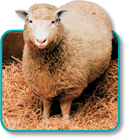Cloning A clone is a member of a population of genetically identical cells produced from a single cell. The technique of cloning uses a single cell from an adult organism to grow an entirely new individual that is genetically identical to the organism from which the cell was taken.
Cloned colonies of bacteria and other microorganisms are easy to grow, but this is not always true of multicellular organisms, especially animals. Clones of animals were first produced in 1952 using amphibian tadpoles. In 1997, Scottish scientist Ian Wilmut stunned biologists by announcing that he had produced a sheep, called Dolly, by cloning.
Figure 15–12 shows the basic steps by which an animal can be cloned. First, the nucleus of an unfertilized egg cell is removed. Next, the egg cell is fused with a donor cell that contains a nucleus, taken from an adult. The resulting diploid egg develops into an embryo, which is then implanted in the uterine wall of a foster mother, where it develops until birth. Cloned cows, pigs, mice, and even cats have since been produced using similar techniques.

FIGURE 15–12 Cloning Animals Animal cloning uses a procedure called nuclear transplantation. The process combines an egg cell with a donor nucleus to produce an embryo. Apply Concepts Why won't the cloned lamb resemble its foster mother?
dd
15.2 Assessment

-
Review Describe the process scientists use to copy DNA.
Infer Why would a scientist want to know the sequence of a DNA molecule?
-
Review How do scientists use recombinant DNA?
Use Analogies How is genetic engineering like computer programming?
-
Review What is a transgenic organism?
Compare and Contrast Compare the transformation of a plant cell with the transformation of an animal cell.
PRACTICE PROBLEM
Design an experiment to find a way to treat disorders caused by a single gene. State your hypothesis and list the steps you would follow. (Hint: Think about the uses of recombinant DNA.)

Table of Contents
- Formulas and Equations
- Applying Formulas and Equations
- Mean, Median, and Mode
- Estimation
- Using Measurements in Calculations
- Effects of Measurement Errors
- Accuracy
- Precision
- Comparing Accuracy and Precision
- Significant Figures
- Calculating With Significant Figures
- Scientific Notation
- Calculating With Scientific Notation
- Dimensional Analysis
- Applying Dimensional Analysis




